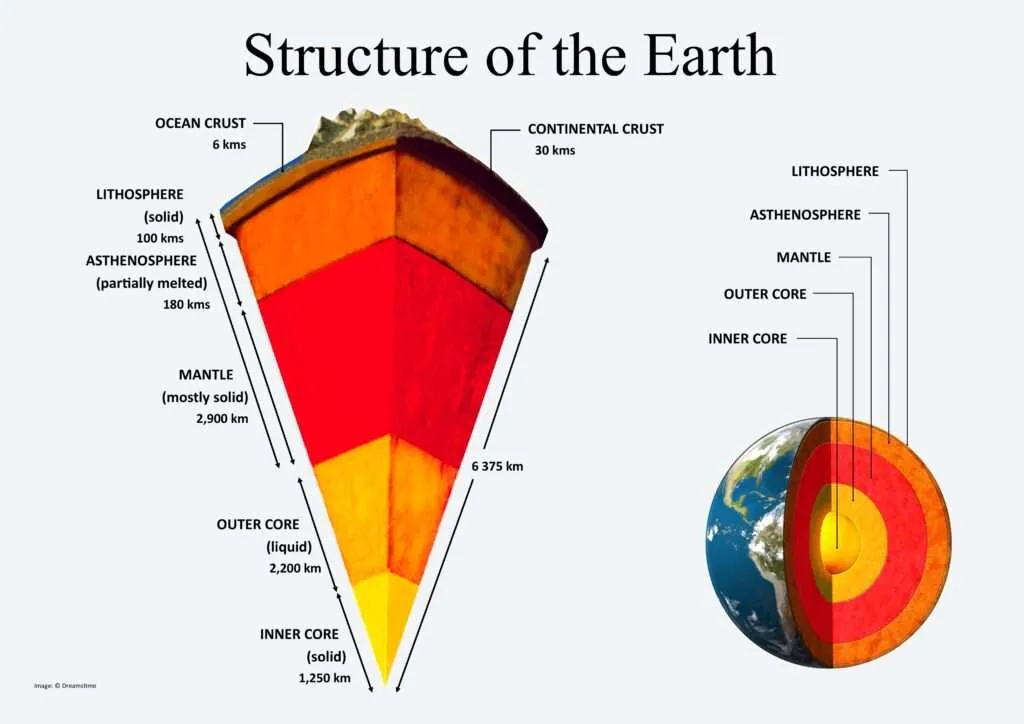
Structure of the Earth:
- The uppermost layer of the earth’s crust which is capable of supporting life is called lithosphere.
- The Interior Structure of Earth is mainly divided in 3 layers: 1) Crust 2) Mantle and 3) Core.
- The crust is the outermost layer, the Mantle is the middle layer whereas the core is the innermost layer of the earth.
- The study of the earth’s interior helps us to understand the original formation of rocks in earth’s crust and their later transformation.
- In this article, we will study these 3 layers in detail. earth structure notes
Latest Current Affairs 2023: Weekly, Monthly Current Affairs (PDF)
Structure of the Earth
Crust
- The outmost layer of the earth made of up solid is called earth’s crust.
- All of the earth’s landform (e.g. mountains, plains and plateaus) are contained within it along with the oceans, seas and lakes.
- The thickness of this layer is about 30 km and density of the rocks ranges from 2.7 to 3 g/cm3.
- The crust is divided into two different types: 1) thin oceanic crust that underlies the ocean basins & 2) thicker continental crust underlies the continents.
- The separation part of the upper crust and the lower crust is called “Conroad Discontinuity.
- The upper part of the crust is rich in Silica and Aluminum in higher proportion. That is why this region is called Sial.
- The lower part is rich in Sima Magnesium in higher proportion and so this region is called Sima.
- The separation part between the lower crust and the mantle is called Mohorovicic Discontinuity or simply Moho.
Mantle
- It is the thick, dense rocky matter surrounding the core with the thickness of about 2900 km.
- The density of substances in the mantle ranges from 3.0 to 4.7 g/cm3.
- The mantle covers the majority of the earth’s volume. This is basically composed of silicate rock rich in Iron & Magnesium.
- The mantle is also divided into upper mantle and lower mantle.
- The upper mantle is also known as Asthenosphere with the thickness of about 290 km and density 5.68 g/cm3.
- The separation part of the upper mantle and the lower mantle is known as the Repetti Discontinuity.
- The separation part of the lower mantle and the core is known as the Gutenberg- Weichert Discontinuity.
Core
- The core is the innermost layer of the earth. This layer is also known as the Barysphere.
- The thickness of this layer is about 3500 km and density is about 9.5-14.5 g/cm3.
- The core is made up of two layers: 1) the outer core and 2) the inner core. The inner core is in solid state whereas the outer core is in liquid state.
- Earth’s core is mainly composed of an Iron and Nickel in smaller amount. Therefore, this layer is also called Nife (Nickel and Iron).
- The separation region between the outer core and the inner core is called as Lehmann Discontinuity.
- Structure of the Earth.
Frequently Asked Questions (FAQ’s)
Q1) What are the different layers of the earth?
Ans. The Interior Structure of Earth is mainly divided in 3 layers: 1) Crust 2) Mantle and 3) Core. The crust is the outermost layer, the Mantle is the middle layer whereas the core is the innermost layer of the earth.
Q2) What are the discontinuities in the interior of the earth?
Ans. Conroad Discontinuity- between inner crust and outer crust; Mohorovicic Discontinuity- between outer crust and mantle; Repetti Discontinuity- between inner mantle and outer mantle; Gutenberg- Weichert Discontinuity- between outer mantle and core; Lehmann Discontinuity- between inner core and outer core.
Q3) Why is it important to study the interior structure of the earth?
Ans, The study of the earth’s interior helps us to understand the original formation of rocks in earth’s crust and their later transformation.
